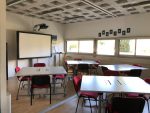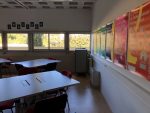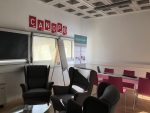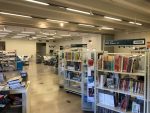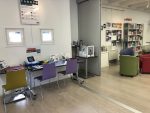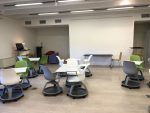De plus en plus, l’ère du numérique favorise la collaboration entre des classes de partout dans le monde! Dans le cadre de son récent séjour en France, notre collaborateur Marc-André Girard nous offre un condensé de terminologie propre au système français, qui pourra vous aider si nécessaire à faire certaines comparaisons avec le système québécois.
La scolarisation en France est obligatoire pour les enfants de six à seize ans, mais les écoles accueillent les enfants dès trois ans. Même, dans certains quartiers défavorisés, les enfants débutent leur scolarisation dès deux ans! Voici la répartition des niveaux d’études scolaires en parcours général pour l’élève, et ce, dès l’âge de deux ans (cycle I) :
Les niveaux d’études
Premier degré :
Cycle I : apprentissages initiaux
- TPS : Toute petite section de maternelle (2-3 ans)
- PS : Petite section de maternelle (3-4 ans)
- MS : Moyenne section de maternelle (4-5 ans)
- GS : Grande section de maternelle (5-6 ans)
Cycle II : apprentissages fondamentaux
- CP : Cours préparatoire (6-7 ans)
- CE 1 : Cours élémentaire 1re année (7-8 ans)
- CE 2 : Cours élémentaire 2e année (8-9 ans)
Cycle III : consolidation
- CM 1 : Cours moyen 1re année (9-10 ans)
- CM 2 : Cours moyen 2e année (10-11 ans)
Second degré :
Collège :
- 6e (11-12 ans)
- 5e (12-13 ans)
- 4e (13-14 ans)
- 3e (14-15 ans) : obtention du Diplôme national du brevet suite à la réussite des examens finaux.
Lycée :
- Seconde (15-16 ans)
- Première (16-17 ans)
- Terminale (17-18 ans) : obtention du baccalauréat général.
Académie, rectorat et CANOPÉ
Les Académies sont l’équivalent des Commissions scolaires québécoises. Elles supervisent les écoles françaises de leur territoire et sont divisées en circonscriptions, donc en sous-région. Sur tout le territoire français, incluant les départements outre-mer, il y a 30 académies.
Chacune est dirigée par un rectorat, dont le recteur est le représentant de l’Éducation nationale française. Ce dernier « garantit l’unité et la cohérence de la parole de l’État » aux assemblées régionales, animées par le préfet de la collectivité régionale. Ce qu’il faut donc comprendre, c’est qu’il y a des champs de compétences qui sont partagés entre l’Académie et la collectivité régionale, donc que la gestion de l’éducation est assumée par les villes, municipalités et les départements et les régions.
Entre le niveau académique et les circonscriptions, il y a la Direction des services départementaux de l’éducation nationale (DSDEN) qui régule au niveau départemental les différentes circonscriptions, bassins d’éducation.
Par ailleurs, l’Académie s’est doté d’une équipe de médiateurs pédagogiques qui, un peu comme le RÉCIT québécois, est responsable d’intervenir en soutien aux enseignants. Il y a donc des conseillers disponibles sans égard aux disciplines enseignées. Pour mener à bien la tâche qui leur est confiée, les conseillers se déplacent fréquemment dans les écoles à la demande des enseignants qui les sollicitent. Ils peuvent travailler individuellement avec l’enseignant volontaire ou aller en classe avec ce dernier.
Ancien éditeur de ressources pédagogiques, chaque CANOPÉ dispose d’un centre de ressources didactiques qui va de divers livres à prêter ou à vendre jusqu’à des outils technologiques à expérimenter : imprimantes 3D, écrans verts, caméras, robots, etc.
Il s’agit donc d’un réseau national dont la mission est de créer des ressources pour les enseignants et les accompagner dans les usages de ces ressources. Il y a donc une question d’opérationnalisation de ces ressources et de mise en application dans les milieux scolaires. Il accompagne également les enseignants dans leur appropriation des technologies scolaires.
La Délégation académique au numérique éducatif (DANE)
Pour sa part, la DANE relève directement de l’Éducation nationale et elle a la responsabilité du déploiement des ressources numériques et informatiques dans les écoles de l’Académie. Elle forme également les enseignants aux orientations pédagonumériques adoptées par cette dernière.
Elle met à la disposition du personnel scolaire des ressources de l’éducation nationale en travaillant davantage au niveau des structures plutôt que de la conseillance pédagogique.
CANOPÉ et la DANE travaillent en parallèle et en collaboration.
L’école supérieure de professorat et de l’éducation (ESPE)
L’ESPE est, en quelques sortes, une combinaison de la faculté d’éducation et de l’école normale. Elle forme donc les enseignants.
Elle entretient des liens étroits avec les Académies pour fixer les besoins en formation, certes, mais également pour assurer le placement des stagiaires.
Notons qu’il existe une trentaine d’ESPE sur le territoire français et que tous les futurs enseignants doivent désormais la fréquenter.
L’École supérieure de l’éducation nationale, de l’enseignement supérieur et de la recherche (ESENESR)
Il s’agit essentiellement d’un organisme de formation de la fonction publique en éducation. Localisée dans la ville de Poitiers, elle forme le personnel d’encadrement ainsi que les cadres supérieurs du scolaire français, en l’occurrence les inspecteurs et les chefs d’établissements.
La formation se déroule à temps partiel et elle inclut un stage de cinq semaines sur place réparties sur les deux années que dure la formation.
Les autres activités de perfectionnement du personnel d’encadrement sont dispensées par les Académies dans la plupart des cas.
Cet article fait partie d’une série publiée par notre auteur et collaborateur Marc-André Girard, dans le cadre de sa participation au Laboratoire d’innovation et du numérique en éducation (LINE) à l’Université de Nice Sophia Antipolis.
Vous pouvez lire l’ensemble des articles de cette série ici.




